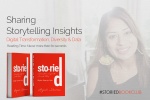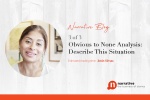In my previous blog on Data Storytelling, I suggested that in the absence of an insight, a Data Analyst should be a Questionologist.
In this blog, I want to share the vital role that an audience plays in generating what we all want from Data….Insights.
Firstly, I would highly recommend that we take the time to reflect upon our respective Internal Presentations Culture. In my corporate roles in Singapore, India and Australia, I have often walked in to presentations feeling like I am about to sit an exam. I had to know it all and my audience were there to test my knowledge, critique me and sometimes pick on irrelevant things like, why is the slide background black!
Why do we do internal presentations?
We may have varying short-term goals associated with an Internal Presentation, but there is only one long-term goal, which is a better business outcome. And this is a common goal of the presenter and the audience.
So, why do we not focus on taking what the presenter has and create a conversation which leads to insights and strategies? As an audience, your most important role is – to find the worth in what we are being presented with and create a conversation that takes us a step closer to our final goal.
Somehow, we treat corporate presentations like a courtroom where we want the other side to lose, but unlike a courtroom, there is no victory in our defeat of the other side. We should perhaps treat internal presentations like a doctor’s consulting room, where a data analyst comes with symptoms in the form of patterns, anomalies and trends and the audience are like doctors who come up with the diagnosis through the right insights based on those symptoms.
Just like a doctor can never deny a patient the diagnosis, as an audience, you should not deny a Data Analyst an insight that you have based on his/her data analysis. Please bear in mind that Data Analysts are not just number crunchers. Should you bring purpose to their roles by keeping them informed of strategic decisions made via data analysis, you will be surprised at how much more value they can add.
In essence, this is what I suggest the audience should do:
1. Create an environment more like a doctor’s consulting room and not like a courtroom.
2. Always remember that you have the same goal as the Data Storyteller, which is a better business outcome.
3. Encourage questions and constructive evaluation of the data trends, anomalies and patterns.
4. If you have the insight on why the data is showing what it is showing, share it with the Data Analyst.
5. Ask the Data Analyst if there are any other information points that will add further value to your key takeaways.
Lastly, unlike most presentations, we do not do Data Storytelling Presentations to provide information and influence alone. We do Data Storytelling to Investigate/Interrogate and reveal insights that lead to better business outcomes.
Narrative’ Data Storytelling Workshop is designed to help business professionals learn how to tell a story that’s hidden in Data for Better Business Outcomes.
"I attended your story telling course some time back. And I've enjoyed keeping up my knowledge with your blog. You may not have realised however, that the Whole of Government is implementing Internet Seperation. Hence I'm not able to access the links to read your articles. Could I suggest including a QR code in your emails so that I can use my mobile to scan it and gain immediate access to the article? It would be most helpful"










